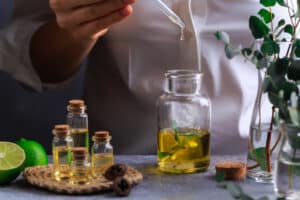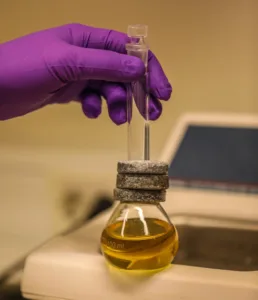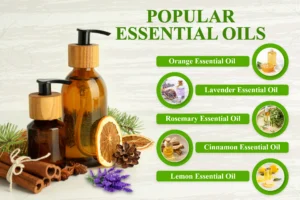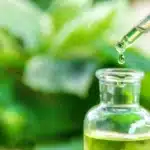What are ESSENTIAL OILS ?
Essential oils are aromatic volatile compounds extracted from plants that give them distinctive aromas and flavors. They are widely used in perfumes, cosmetics, aromatherapy, the food and beverage industries, pharmaceuticals, insecticides and other products. 1
Sources of essential oils

Essential oils are typically derived from one or more plant parts, such as rhizomes (ginger, calamus, curcuma, orris), fruits (bergamot, orange, lemon, juniper), leaves (mint, lemongrass, jamrosa), stems (geranium, patchouli, petitgrain, verbena, cinnamon), bark (cinnamon, cassia, pine), wood (cedar, sandal, pine), roots (vetiver, Saussurea), seeds (fennel, coriander, caraway, dill, nutmeg) and gums or oleoresin exudations (balsam of Peru, storax, myrrh, benzoin). 1
The production and use of essential oils and perfumes worldwide are rising extremely rapidly. Production technologies are crucial to raising essential oils’ total yield and caliber. In many regions of the world, ancient methods for processing essential oils are still widely employed and are particularly important. There are several traditional and modern techniques employed. 1
Traditional Methods:
1. Water Distillation: The plant material is completely immersed in water and heated to boiling. The volatile oils vaporize and are condensed along with steam. The essential oil is separated from the aqueous layer or hydrosol. It is one of the oldest methods, adaptable for powdered materials like almonds, rose petals, etc. Disadvantages include hydrolysis of some compounds and loss of water-soluble constituents. 1
2. Steam Distillation: Live steam is passed through the plant material, causing the essential oils to vaporize without burning the plant material. The distillate is condensed, and the oil is separated from the hydrosol. 1
3. Expression/ cold pressing: It is used only for citrus peel oils. The whole fruit is pressed to rupture the oil sacs and release the essential oil-water emulsion, separated by centrifugation. Methods include écuelle (pricking fruit over a sponge), sfumatrice (metal rollers crushing peels) and pelatrice (abrasive chambers). 1
4. Enfleurage: Delicate, freshly picked flowers are placed over purified fat, which absorbs the aroma compounds emitted by the flowers. After repeatedly charging with fresh flowers, the fat-soluble oil is extracted from the saturated fat using alcohol. Mainly used for extract production of flowers like jasmine, tuberose, etc. 1
5. Solvent Extraction: Organic solvents like hexane or petroleum ether selectively extract and dissolve the fragrant oil from plant materials. After solvent removal through distillation, the concentrated extract containing the essential oil is obtained, known as an absolute or concrete. 1
Also Read: Untapping The Power of Nature: Essential Oil Extraction Methods
Modern Techniques:

1. Solid Phase Microextraction (SPME): A fused silica fiber with an adsorbent polymer coating extracts volatiles from the headspace of the material. The adsorbed compounds are thermally desorbed for analysis or cryo-trapped for essential oil production. It requires a very small sample size. 1
2. Supercritical Fluid Extraction (SFE): Supercritical carbon dioxide or other gases are used as selective, inert solvents. Under critical temperature and pressure conditions, they have liquid and gas properties. SFE produces high-quality extracts, free of solvent residues while preventing thermal damage to thermolabile compounds. 1
3. Phytosol Extraction: The essential oils are dissolved in a natural, high-boiling solvent called phytol at near-ambient temperatures. After filtration, the essential oil is retrieved by vacuum distillation of the recycled solvent. Avoids the disadvantages of solvent extraction methods. 1
4. Protoplast Technique: Many essential oil constituents are non-volatile, water-soluble glycosides in plant cells. When the cell walls and membranes are enzymatically digested to release the protoplasts, they undergo hydrolysis, releasing the volatile aglycones into the aqueous phase for extraction. 1
5. Microwave-Assisted Processes: The application of microwave energy during hydrodistillation significantly reduces the extraction time and energy costs. Optimizing microwave power and duration improves both oil quality and yield. 1
6. Molecular Distillation: Using a short distillation path under a high vacuum minimizes thermal damage to heat-sensitive materials while operating at lower temperatures, making it suitable for molecular compounds that form azeotropes or have a wide boiling range. 1
The choice of extraction method depends on various factors like chemical stability, thermosensitivity, desired organoleptic properties of the final product, economics, regulatory requirements, end-use application, etc. In some cases, combining different techniques may be most effective in optimizing oil quality, yield and costs. Proper practices, from harvesting, drying, and extraction to the final packaging and storage, are critical to obtaining the highest quality essential oils. 1
Most Popular ways of extracting essential oils among all
1. Distillation:
- Simple Distillation: Think of boiling water to make steam through the plant. This method is too hot for some plants.
- Steam Distillation: This is a special way of using steam to remove the oils. It’s the most common and works well. 2
2 . Cold Pressing (Expression): This is like squeezing juice from a fruit, but it is done with plants. It’s great for fruits like lemons and oranges. 2
3. Solvent Extraction: This uses special liquids like ethanol or something from petroleum to get the oils out. We must be careful to remove any leftover liquid. 2
4. Supercritical and Subcritical CO2 Extraction: This uses carbon dioxide to act like a superhero solvent. It is in high demand, especially for cool things like hemp extraction. 2
Understanding CO2 Supercritical Extracts:
CO2 Supercritical Extracts, often called CO2 Extracts, are created using supercritical carbon dioxide extraction. Carbon dioxide, the gas we breathe, turns extraordinary when put under critical pressure, becoming both a liquid and a gas simultaneously; this magical state is called supercritical. In this state, carbon dioxide acts as a powerful solvent, dissolving natural components from plant material. Once the extraction is complete, the CO2 returns to its normal gaseous state, leaving behind the natural CO2 Extract. 3
CO2 Supercritical Extracts and Carrier Oils:
CO2 Supercritical extraction is not limited to creating aromatic extracts; it can also produce superior lipids, known as carrier oils. Unlike traditional cold pressing, which can generate heat, CO2 extraction captures more beneficial plant materials. These extracts are gaining popularity and are available in glass bottles or small jars in the case of thicker extracts. 3
Popular Essential Oils:
1. Lavender Essential Oil: Derived from the lavender plant, lavender oil emerges as a skincare champion. It is on the list of the best essential oils. Diluting this potent elixir is vital before application. Its versatility shines through in addressing acne, eczema, and blotchy skin. A gentle toner or a wrinkle-reducing moisturizer caters to diverse needs. Its anti-inflammatory prowess relieves burns and wounds, promoting faster healing and minimizing scars. Lavender oil isn’t just an oil; it’s a holistic skin solution for a healthier and radiant complexion. 4
2. Orange Essential Oil: Orange essential oil is derived from the peel of the sweet orange (Citrus sinensis). This is accomplished using a process known as cold pressing, which involves applying pressure to the rind to extract the oils. The orange plant’s leaves and blossoms can also be used. 5
3. Rosemary Essential Oil: Rosemary essential oil, extracted from the evergreen shrub Rosemary, is renowned for potential health benefits, including brain support and hair growth. It is also popular for possessing powerful antibacterial, cytotoxic, antimutagenic, antioxidant, antiphlogistic and chemo preventive properties. 6
4. Cinnamon Essential Oil: The warm, sweet scent of cinnamon evokes happy memories. Cinnamon oil, prized for its lush fragrance, boasts antibacterial, antifungal, antidiabetic, and antioxidant properties. 7
5. Lemon Essential Oil: Lemon essential oil comes from lemon peels and is a natural remedy. You can put it on your skin, in the air, or inhale it. It is believed to fight tiredness, help with feeling sad, clear skin, and fight germs. 8
Creating essential oils involves different processes, and the selection depends on the desired outcome for each type of oil. Each method brings out unique qualities, scents, and benefits from the plant material. Understanding the characteristics, the final product guides us in choosing the appropriate process, ensuring that each essential oil meets its specific requirements and qualities. For more information on essential oils, you can get back to us at [email protected]
Note: While the information provided is based on credible references, we do not make any specific claims or guarantees. It is important to consult with your healthcare advisor for personalized advice and guidance related to your health.







